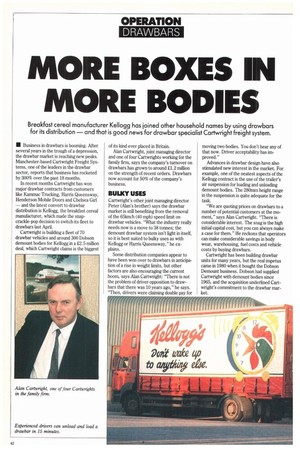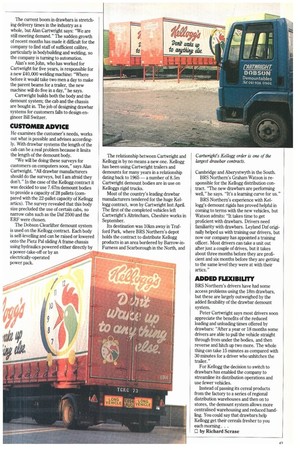MORE BOXES IN MORE BODIES
Page 44

Page 45

If you've noticed an error in this article please click here to report it so we can fix it.
• Business in drawbars is booming. After several years in the trough of a depression, the drawbar market is reaching new peaks. Manchester-based Cartwright Freight Systems, one of the leaders in the drawbar sector, reports that business has rocketed by 300% over the past 18 months.
In recent months Cartwright has won major drawbar contracts from customers like Kammac Trucking, Harris Queensway, Henderson Mobile Doors and Chelsea Girl — and the latest convert to drawbar distribution is Kellogg, the breakfast cereal manufacturer, which made the snapcrackle-pop decision to switch its fleet to drawbars last April.
Cartwright is building a fleet of 70 drawbar vehicles and around 300 Dobson demount bodies for Kellogg in a £2.5 million deal, which Cartwright claims is the biggest of its kind ever placed in Britain.
Alan Cartwright, joint managing director and one of four Cartwrights working for the family firm, says the company's turnover on drawbars has grown to around 21.2 million on the strength of recent orders. Drawbars now account for 50% of the company's business.
Cartwright's other joint managing director Peter (Alan's brother) says the drawbar market is still benefiting from the removal of the 65Icm/h (40 mph) speed limit on drawbar vehicles. "What the industry really needs now is a move to 38 tonnes; the demount drawbar system isn't light in itself, so it is best suited to bulky uses as with Kellogg or Harris Queensway," he explains.
Some distribution companies appear to have been won over to drawbars in anticipation of a rise in weight limits, but other factors are also encouraging the current boom, says Alan Cartwright: "There is not the problem of driver opposition to drawbars that there was 10 years ago," he says. 'Then, drivers were claiming double pay for moving two bodies. You don't hear any of that now. Driver acceptability has improved."
Advances in drawbar design have also stimulated new interest in the market. For example, one of the neatest aspects of the Kellogg contract is the use of the trailer's air suspension for loading and unloading demount bodies. The 280nun height range in the suspension is quite adequate for the task.
"We are quoting prices on drawbars to a number of potential customers at the moment," says Alan Cartwright. "There is considerable interest. The snag is the high initial capital cost, but you can always make a case for them." He reckons that operators can make considerable savings in body wear, warehousing, fuel costs and vehicle costs by buying drawbars.
Cartwright has been building drawbar units for many years, but the real impetus came in 1980 when it bought the Dobson Demount business. Dobson had supplied Cartwright with demount bodies since 1965, and the acquisition underlined Cartwright's commitment to the drawbar market. The current boom in drawbars is stretching delivery times in the industry as a whole, but Alan Cartwright says: "We are still meeting demand." The sudden growth of recent months has made it difficult for the company to find staff of sufficient calibre, particularly in bodybuilding and welding, so the company is turning to automation.
Alan's son John, who has worked for Cartwright for five years, is responsible for a new 240,000 welding machine: "Where before it would take two men a day to make the parent beams for a trailer, the new machine will do five in a day," he says.
Cartwright builds both the body and the demount system; the cab and the chassis are bought in. The job of designing drawbar systems for customers falls to design engineer Bill Switzer.
He examines the customer's needs, works out what is possible and advises accordingly. With drawbar systems the length of the cab can be a real problem because it limits the length of the demount body.
"We will be doing these surveys for customers on computers soon," says Alan Cartwright. "All drawbar manufacturers should do the surveys, but I am afraid they don't." In the case of the Kellogg contract it was decided to use 7.67m demount bodies to provide a capacity of 28 pallets (compared with the 22-pallet capacity of Kellogg artics). The survey revealed that this body size precluded the use of certain cabs, so narrow cabs such as the Daf 2500 and the ERF were chosen.
The Dobson Clearlifter demount system is used on the Kellogg contract. Each body is self-levelling and can be raised or lowered onto the Pietz Pal sliding A frame chassis using hydraulics powered either directly by a power-take-off or by an electrically-operated power pack. The relationship between Cartwright and Kellogg is by no means a new one. Kellogg has been using Cartwright trailers and demounts for many years in a relationship dating back to 1965— a number of 8.5m Cartwright demount bodies are in use on Kefloggs rigid trucks.
Most of the country's leading drawbar manufacturers tendered for the huge Kellogg contract, won by Cartwright last April. The first of the completed vehicles left Cartwright's Altrincham, Cheshire works in September.
Its destination was 10kin away in Trafford Park, where BRS Northern's depot holds the contract to distribute Kellogg products in an area bordered by Barrow-inFurness and Scarborough in the North, and Cambridge and Aberystwyth in the South.
BRS Northern's Graham Watson is responsible for the Kellogg distribution contract. "The new drawbars are performing well," he says. "It's a learning curve for us."
BRS Northern's experience with Kellogg's demount rigids has proved helpful in coming to terms with the new vehicles, but Watson admits: "It takes time to get proficient with drawbars. Drivers need familiarity with drawbars. Leyland Daf originally helped us with training our drivers, but now our company has appointed a training officer. Most drivers can take a unit out after just a couple of drives, but it takes about three months before they are proficient and six months before they are getting to the same level they were at with their artics."
BRS Northern's drivers have had some access problems using the 18m drawbars, but these are largely outweighed by the added flexibility of the drawbar demount system.
Peter Cartwright says most drivers soon appreciate the benefits of the reduced loading and unloading times offered by drawbars: "After a year or 18 months some drivers are able to pull the vehicle straight through from under the bodies, and then reverse and hitch up two more. The whole thing can take 15 minutes as compared with 30 minutes for a driver who unhitches the trailer."
For Kellogg the decision to switch to drawbars has enabled the company to streamline its distribution operations and use fewer vehicles.
Instead of passing its cereal products from the factory to a series of regional distribution warehouses and then on to stores, the demount system allows more centralised warehousing and reduced handling. You could say that drawbars help Kellogg get their cereals fresher to you each morning. .
0 by Richard Scrase
























































































